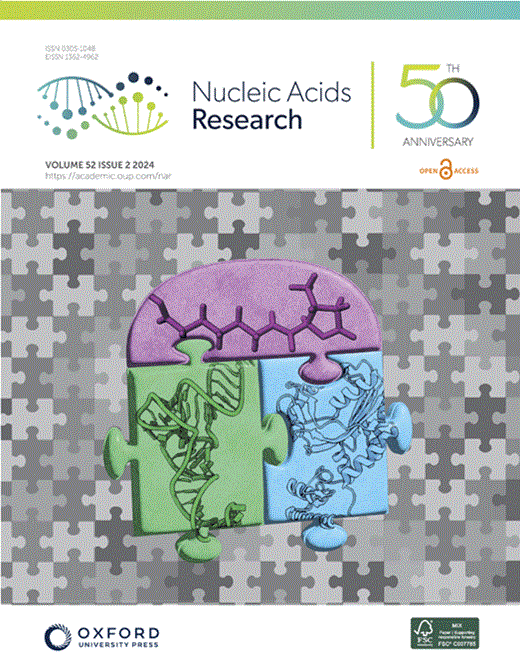The conformation of FOXM1 homodimers in vivo is crucial for regulating transcriptional activities
IF 16.6
2区 生物学
Q1 BIOCHEMISTRY & MOLECULAR BIOLOGY
引用次数: 0
Abstract
Conformational changes in a transcription factor can significantly affect its transcriptional activity. The activated form of the FOXM1 transcription factor regulates the transcriptional network of genes essential for cell cycle progression and carcinogenesis. However, the mechanism and impact of FOXM1 conformational change on its transcriptional activity in vivo throughout the cell cycle progression remain unexplored. Here, we demonstrate that FOXM1 proteins form novel intermolecular homodimerizations in vivo, and these conformational changes in FOXM1 homodimers impact activity during the cell cycle. Specifically, during the G1 phase, FOXM1 undergoes autorepressive homodimerization, wherein the αβα motif in the C-terminal transcriptional activation domain interacts with the ββαβ motif in the N-terminal repression domain, as evidenced by FRET imaging. Phosphorylation of the αβα motif by PLK1 at S715/S724 disrupts ββαβ–αβα hydrophobic interactions, thereby facilitating a conserved αβα motif switch binding partner to the novel intrinsically disordered regions, leading to FOXM1 autostimulatory homodimerization persisting from the S phase to the G2/M phase in vivo. Furthermore, we identified a minimal ββαβ motif peptide that effectively inhibits cancer cell proliferation both in cell culture and in a mouse tumor model, suggesting a promising autorepression approach for targeting FOXM1 in cancer therapy.体内 FOXM1 同源二聚体的构象对调节转录活动至关重要
转录因子的构象变化会显著影响其转录活性。FOXM1 转录因子的活化形式调控着细胞周期进展和癌变所必需的基因转录网络。然而,FOXM1构象变化对其在体内整个细胞周期进展过程中的转录活性的机制和影响仍有待探索。在这里,我们证明了 FOXM1 蛋白在体内形成了新的分子间同二聚体,而 FOXM1 同二聚体的这些构象变化影响了细胞周期中的活性。具体来说,在 G1 期,FOXM1 会发生自抑性同源二聚体化,其中 C 端转录激活结构域中的αβα motif 与 N 端抑制结构域中的ββαβ motif 相互作用,这可以通过 FRET 成像得到证明。PLK1 在 S715/S724 处对 αβα motif 进行磷酸化会破坏 βαβ-αβα 疏水相互作用,从而促进保守的 αβα motif 开关结合伙伴进入新的内在无序区,导致 FOXM1 自刺激同二聚体在体内从 S 期持续到 G2/M 期。此外,我们还发现了一种最小 ββαβ motif 肽,它能在细胞培养和小鼠肿瘤模型中有效抑制癌细胞增殖,这表明在癌症治疗中靶向 FOXM1 的自抑方法大有可为。
本文章由计算机程序翻译,如有差异,请以英文原文为准。
求助全文
约1分钟内获得全文
求助全文
来源期刊

Nucleic Acids Research
生物-生化与分子生物学
CiteScore
27.10
自引率
4.70%
发文量
1057
审稿时长
2 months
期刊介绍:
Nucleic Acids Research (NAR) is a scientific journal that publishes research on various aspects of nucleic acids and proteins involved in nucleic acid metabolism and interactions. It covers areas such as chemistry and synthetic biology, computational biology, gene regulation, chromatin and epigenetics, genome integrity, repair and replication, genomics, molecular biology, nucleic acid enzymes, RNA, and structural biology. The journal also includes a Survey and Summary section for brief reviews. Additionally, each year, the first issue is dedicated to biological databases, and an issue in July focuses on web-based software resources for the biological community. Nucleic Acids Research is indexed by several services including Abstracts on Hygiene and Communicable Diseases, Animal Breeding Abstracts, Agricultural Engineering Abstracts, Agbiotech News and Information, BIOSIS Previews, CAB Abstracts, and EMBASE.
 求助内容:
求助内容: 应助结果提醒方式:
应助结果提醒方式:


